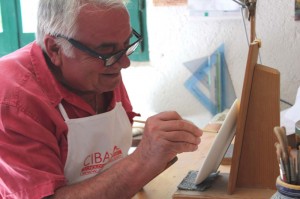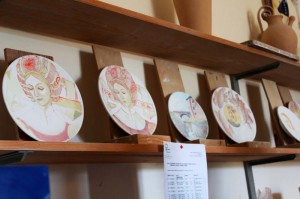In the small Marche town famous for its maiolica ceramics, a native son tries to keep the ancient art alive.
URBANIA, Italy — A painter is hard at work in his Urbania laboratory.
Silvio Biagini lifts a newly made ceramic plate off his shelf. He runs his fingers around the surface and prepares to adorn its blank face, paintbrush in hand. In an instant, images from Renaissance history start to form on it.
Biagini has dedicated a great part of his life to painting the tin-glazed ceramics called maiolica, sometimes anglicized to majolica. He is a leading artisan in the town of Urbania who still practices this art. He is also leading the effort to keep this ancient tradition from losing its identity.
Maiolica dates back to the 15th century in Renaissance Italy. In the town of Urbania (formerly known as Castledurante), artisans were well-known for creating these ceramics. On vases, dishes and pots, white backgrounds were decorated with historical, mythical, or religious images in vibrant colors.
Like Chinese porcelain, maiolica ceramics glisten with shiny, smooth texture. They are covered in glaze and a white opaque substance called tin oxide. After the paint is applied on the unfired glaze then cooked, it develops brilliant colors on the surface.
For centuries, Renaissance maiolica from Urbania have been a significant part of Italy’s history. Many of its pieces are placed in museums all over the world, including the International Museum of Ceramics in Faenza, Museo Civico and Museo Diocensano in Urbania, and the Metropolitan Museum of Art in New York City.
Today, maiolica ceramics are still made and sold in Urbania. But it is currently considered the only town in the Marche region that preserves this ancient tradition.
Urbania’s ceramics are unique and famous because they are exact replicas of art works from the Renaissance. They are also made from clay of rich sediment containing low iron, which brings out a paler color when cooked.
[pullquote]It’s an activity that requires passion,” he said. “If you have passion, everything is easier.[/pullquote]
Though workshop artisans who create these do not follow a specific standard for setting prices, they sell their ceramics based on how long it took to produce them—hence a piece made in three hours would be triple the cost of an item produced in one hour.
Biagini is one of these workshop artisans, but there is a problem: the ceramics of Urbania are starting to lose public interest. Ten years ago, with the circulation of the euro in Italy, there was a large drop in sales. The ceramics in town were glutted. And now that maiolica is losing popular attention, younger people no longer want to learn the art or carry it into the future.
Being a fervent artisan, Biagini refuses to let go of traditional ceramic art.
“It’s an activity that requires passion,” he said. “If you have passion, everything is easier.”
Biagini spent his entire life in Urbania. As early as the age of 8, he was a lover of the classics and arts, inspired to paint by the natural beauty of his hometown. But after he received his art diploma in Varese, Biagini declined to take up an artistic profession.
“Belly comes first,” he says.
Biagini needed a job that would pay him enough to take care of his family. So he worked at a hospital, where he was greeted by ancient art again. At the hospital, Biagini became close to an ill patient named Federico Melis, who was a ceramist.
Melis introduced Biagini to the art of ceramics. Intrigued, he started taking evening classes. Then after 30 years of working at the hospital, Biagini retired and opened his own ceramic workshop.
Many of Biagini’s works are paintings of Urbania’s landscape, historical figures and scenes from Roman mythology. Even today, after the economic slump hit Urbania’s artisans, Biagini still paints ceramics.
As vice president of Friends of Ceramics (Associazione Amici della Ceramica), which he founded in 1995 with ceramists Orazio Bindelli and Antonio Violoini, Biagini tries to spread awareness of ceramics. The association organizes educational lectures, and provides free evening and holiday courses.
They also have demonstrations at schools to encourage the faculty to teach young students how to create ceramics. They figure that it is through the younger generation that tradition can be carried on into the future.
Though it is difficult to make a living, Biagini still has his ceramic workshop open, with another job on the side as an insurance salesman. It is his very passion and perseverance that keeps ceramics in Urbania alive.
“Tradition is important,” he says. “If we lose our history, the future does not exist.”
Multimedia

